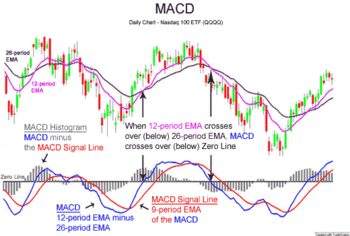Stock Market Basics: Understanding Charts & Indicators
Table of Contents
Stock Market Basics
We know how daunting the world of trading can be for an outsider. When you first look at this stuff, all you see are squiggly lines on graphs, strange looking candles and numbers all over the place. Fortunately, Turbo Option Trading’s stock trading for beginners brings newbies up to speed quickly on the stock market basics over the course of their 5 day trial. However if you want to make as much money during your trial (and beyond!) as possible, it’s helpful to understand what’s being identified in the live trading rooms. To help with this, today we will go over many of the jargon and indicators you’ll encounter with us and each are demonstrated in the above video.
MACD
MACD is an acronym for “Moving Average Convergence Divergence”. It’s an indicator that is used to help deduce the direction of a stock. We look at it on 3, 15 and 60 minute charts. Simply put, when it rises, stocks go higher. When it falls, stocks go lower.

Minute Period Moving Average
These are not to be confused with Simple Moving Averages. These averages are on the minute scale. When they cross over, stocks tend to go way down. Since daytraders move on such tight timeframes, we will discuss this moving average quite a bunch.
CCI
Another useful indicator. CCI stands for Commodity Channel Index. This technical indicator measures the difference between the current price and the historical average price. When the CCI goes higher, stocks go higher.
%DS and %DA
%DS and %DA refer to two commonly used metrics for analyzing stock performance. %DS, or Percentage Daily Change, indicates the percentage difference between a stock’s closing price on the current trading day and its closing price on the previous trading day. This metric provides insight into the short-term volatility and momentum of a stock, helping traders gauge the direction and intensity of price movements over a single trading session.
On the other hand, %DA, or Percentage Daily Average, calculates the percentage difference between a stock’s current price and its average price over a specified period, typically the last 50 or 200 trading days. %DA offers a broader perspective on a stock’s performance, smoothing out short-term fluctuations and revealing its longer-term trend. Both %DS and %DA are valuable tools for investors and traders seeking to understand and interpret stock market movements for informed decision-making.
Volume
“Volume” refers to the total number of shares traded during a specific period, typically a trading day. This metric helps investors and traders assess the relative level of interest and activity in a particular stock on a given day compared to its historical trading patterns.
Bollinger Bands
Bollinger Bands are a technical analysis tool used by traders to gauge the volatility and potential price movements of a financial instrument, such as a stock. These bands consist of three lines: a simple moving average (SMA) in the middle and two outer bands that are standard deviations away from the SMA. The standard deviation is typically set to two, which encompasses approximately 95% of the price data within the bands. The upper and lower bands represent dynamic levels of support and resistance, respectively.
When the price touches or crosses the upper band, it may indicate that the instrument is overbought, suggesting a potential reversal or correction. Conversely, when the price touches or crosses the lower band, it may suggest that the instrument is oversold, potentially signaling a buying opportunity. Traders often use Bollinger Bands in conjunction with other technical indicators to confirm trading signals and identify potential entry or exit points in the market.
Conclusion
Good job at making it to the tip of the iceberg. For those familiar with our Youtube channel, these indicators are constantly being monitored as we set up and plan trades. With this lesson in your back pocket, anyone can enter the live trading room on their 5 day trial and understand the logic at play. So what are you waiting for? Get in there!




